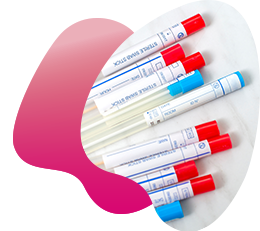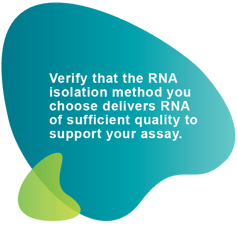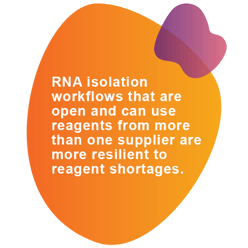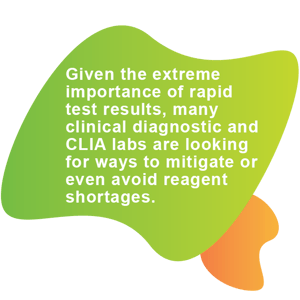Originally published : Wed, October 14, 2020 @ 5:25 PM
 Updated : Thu, February 3, 2022 @ 4:39 PM
Updated : Thu, February 3, 2022 @ 4:39 PM
Clinical and diagnostic labs worldwide are still experiencing supply chain challenges with their SARS-CoV-2 testing workflows. A few years into the pandemic and the system still struggles to keep up with demand during outbreaks of variants and/or other respiratory diseases like flu or RSV. These challenges limit testing volume and delay the delivery of results that help individuals make decisions on quarantining, working, and travelling, and are essential for keeping communities safe as they navigate a return to normalcy.
Given the extreme importance of rapid test results, many clinical diagnostic and CLIA labs are looking for ways to mitigate or even avoid reagent shortages. To help lab managers and directors evaluate alternatives, we’ve focused on the RNA extraction step and put together a list of considerations for choosing a SARS-CoV-2 RNA isolation method.
Consideration 1: What type of samples can it handle?
Currently, public health agencies like the US Centers for Disease Control and Prevention (CDC) are recommending that initial diagnostic testing be done on upper respiratory samples.1 They also recommend obtaining lower respiratory samples, when possible, and a recent meta-analysis of studies comparing the sensitivity of sputum, nasopharyngeal (NP) and oropharyngeal (OP) specimens found that sputum testing led to significantly higher rates of SARS-CoV-2 detection, followed by NP and then OP samples.2
However, when it comes to RNA isolation methods, not all of them are suitable for use with all of the different upper and lower respiratory sample types. For example, spin column-based methods may become clogged when used with samples containing high levels of mucus, such as may happen with sputum.3
| Take-home message: When choosing an RNA isolation method, make sure it is compatible with the types of specimens you will be testing. If you’re just testing NP or OP samples, spin columns, magnetic beads, and organic extraction methods will all work. But for samples like sputum, magnetic bead methods are a better choice. |
Consideration 2: Can it deliver clean enough RNA?
 |
While RT-qPCR can be a very sensitive detection method, the reaction can be inhibited by components in the specimen as well as by isolation reagents such as ethanol. Low amounts of inhibitors can reduce the sensitivity of your assay or even lead to a failed assay as a result of contamination. |
| Take-home message: Verify that the RNA isolation method you choose delivers RNA of sufficient quality to support your assay. You can run studies using known amounts of a control RNA spiked into appropriate specimens and verify that the qPCR assay is not being inhibited. |
Consideration 3: Will it recover a majority of the RNA?
Not every RNA isolation method will recover all or most of the RNA in your sample. But insufficient recovery could lead to a false negative result, potentially impacting both personal health and virus spread.
| Take-home message: As with the previous consideration, you can run studies using known amounts of a control RNA spiked into appropriate specimens and verify that your RNA isolation method consistently recovers sufficient amounts of the spiked-in RNA. |
Consideration 4: Is it scalable? Can it be done in high-throughput and/or with automated liquid handlers?
One of the biggest challenges diagnostics labs have faced is having to rapidly scale up testing to handle the tremendously large number of samples. However, the three main methods for isolating RNA—magnetic beads, spin column, and organic extraction3 - are not all compatible with fast, large-scale testing.
Organic extraction methods, such as with phenol or chloroform, are the least scalable as they require a lot of manual processing.
Spin columns can support some high-throughput workflows, but the need for centrifugation necessitates manual rather than robotic handling, which can limit scale and throughput.
Magnetic bead-based methods are the most amenable to automated, high-throughput testing workflows and are generally the ones that are recommended for SARS-CoV-2 testing by the CDC.3
| Take-home message: Make sure that the RNA isolation method you choose is compatible with your workflows and expected throughputs. |
Consideration 5: What is the turnaround time?
In many ways, the question of turnaround time is very similar to scalability. Methods that require a lot of manual steps will typically have longer turnaround times, whereas automatable workflows have the potential to be faster and run around the clock.
| Take-home message: Make sure that the turnaround time for your RNA isolation method is consistent with your expected total assay turnaround time. |
Consideration 6: Is it an open or closed platform?
| Another of the big challenges with SARS-CoV-2 testing has been periodic shortages of RNA isolation reagents. As we mentioned earlier, these shortages are expected to occur again during flu season since the same reagents are used for both tests. Some RNA isolation systems are “closed” systems, which means that they only work with the reagents from the authorised vendor. To maximise flexibility and give you the option to use isolation reagents from different suppliers, you may want to find an RNA isolation method that is part of an “open” system and can be used with any automated or manual workflow. |  |
| Take-home message: You may be more vulnerable to reagent shortages with RNA isolation methods that are part of a closed system since you are limited to a single supplier. RNA isolation workflows that are open and can use reagents from more than one supplier are more resilient to reagent shortages. |
How LGC, Biosearch Technologies can support your SARS-CoV-2 RNA isolation needs
Biosearch Technologies offers a number of options for RNA isolation to support SARS-CoV-2 testing.
If you look at our sbeadex™ magnetic bead technology, you’ll find that it easily meets all of the considerations we’ve discussed:
- We’ve demonstrated the ability of our sbeadex Pathogen Nucleic Acid Purification Kit to work well with both NP and sputum specimens, recovering all of a spiked-in RNA sample—see the data in the application note.
- The sbeadex purification protocol uses water-based wash buffers to reduce solvent carryover, resulting in an absence of PCR inhibitors in the final eluate.
- As a magnetic bead-based method, it is fast, easily scalable and compatible with any open diagnostic workflow, including the oKtopure™ automated nucleic acid extraction system.
We also offer a more rapid extraction solution, although it is not as optimal for high-throughput SARS-CoV-2 testing:
- The QuickExtract™ RNA Extraction Kit has also been successfully used in detecting SARS-CoV-2. Its simple, one-tube protocol can be automated to extract DNA in less than eight minutes for many sample types but supports slightly lower sensitivity and purity than sbeadex technology.
Resilience is critical for SARS-CoV-2 workflows

Regardless of which RNA isolation method you ultimately end up choosing, the past year has emphasised the importance of building flexibility and resilience into your SARS-CoV-2 workflows. Employing more than one type of RNA isolation method and/or open RNA isolation methods can help keep your lab producing test results if RNA isolation reagents from a specific vendor are unavailable. However, RNA isolation is just one part of the SARS-CoV-2 workflows. We hope that by focusing on the importance of building resilience into the RNA isolation portion of your testing workflow, we’ve inspired you to consider other ways you can optimise your operations to keep those critical SARS-CoV-2 test results flowing from your lab.
References
- Information for Laboratories about Coronavirus (COVID-19). Centers for Disease Control and Prevention. https://www.cdc.gov/coronavirus/2019-ncov/lab/guidelines-clinical-specimens.html. Published 2020. Accessed Oct. 3, 2020.
- Mohammadi A, et al. SARS-CoV-2 detection in different respiratory sites: A systematic review and meta-analysis. EBioMedicine. 2020 Sep; 59: 102903. PMCID: PMC7380223.
- Ravi N, et al. Diagnostics for SARS-CoV-2 detection: A comprehensive review of the FDA-EUA COVID-19 testing landscape. Biosens Bioelectron. 2020 Oct 1; 165: 112454. PMCID: PMC7368663.

